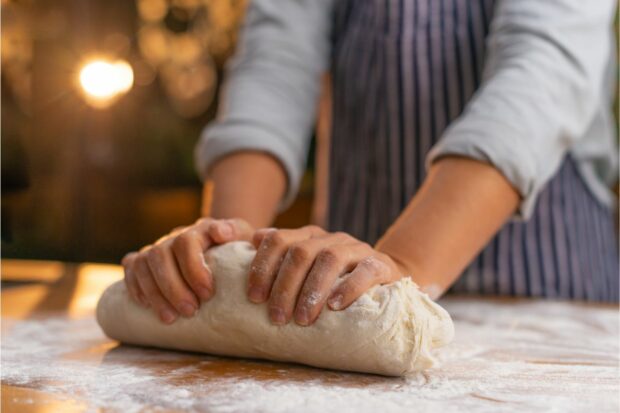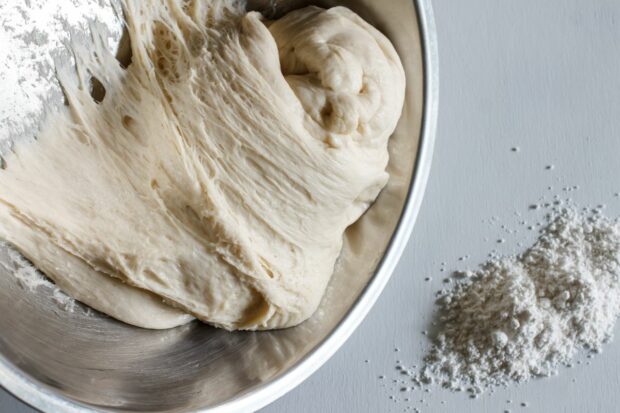Homemade pizza is not just delicious—it’s one of the most enjoyable and fun dishes to make with family or friends. Who doesn’t love hand-picking their toppings and adding exactly the right amount? Making pizza dough, however, might get you into a rather sticky situation. Pizza dough is not actually that difficult to master, but it can be quite tricky at first as you figure out your crafting and proofing methods. The most common challenge is dealing with the sticky dough.
If you find that your pizza dough is overly sticky, there are two likely culprits: too much moisture or not enough kneading. The good news is, they’re both simple to address, and with a little practice, you should end up with excellent dough. Keep in mind that pizza dough will always be a bit tacky due to its higher moisture content, which is what contributes to its quintessential light and crisp texture. I’ll walk you through how to troubleshoot overly sticky dough and give you some tips on handling your sticky pizza dough with ease.
Common Reasons for Sticky Pizza Dough

Not Enough Kneading
This is always the best place to start your investigation. To make proper pizza dough, you should be using a “strong” flour; 00 pizza flour (200–300 W) is most common. Flour strength is measured using the W index. A higher W is a flour with greater protein content, which will result in that stretchy and eventually chewy dough necessary for pizza.
Gluten is the main protein in flour, and the glutens develop through kneading. If you haven’t kneaded your pizza dough long enough—typically between 15 and 30 minutes—this should be your first tactic to address an overly sticky dough. Continue kneading until your dough becomes smooth and just slightly tacky. If you’ve thoroughly kneaded your dough and it’s still far too sticky, you may have too much moisture.

Too Much Moisture
Pizza dough does have a slightly higher moisture content than other doughs, which is why it will inherently remain somewhat sticky. You should be shooting for a moisture content between 60% and 70%. This means that for every 100 grams of flour, you want 60–70 grams of water. Finding the perfect ratio will take some experimentation, and if you generally find handling a stickier dough to be frustrating, I’d start with something closer to 60% until you get used to it.
There are a couple of reasons your dough might have too much moisture, so let’s investigate them each a bit further.
Too Much Water
The most common reason a dough may have too much moisture is that you’ve added too much water. This is an easy fix—your pizza dough is completely salvageable. Simply add flour to your dough in small amounts—no more than a tablespoon or two at a time—until you reach the desired consistency.
This can be a somewhat time-consuming venture, as you’ll want to knead your dough for at least five minutes after each addition to develop the new glutens. Since adding too much flour can lead to a dry and unworkable dough, always try kneading your dough more first, and if it’s still too sticky, you can start adding small amounts of flour.

Wrong Flour
Flours with higher protein content will absorb more water. As we’ve mentioned, standard 00 pizza flour is a high-protein type of flour, so it will absorb more water than your typical white, all-purpose flour.
If you’re following a pizza dough recipe and not using the right flour, the results will be unpredictable. Making pizza dough out of all-purpose flour isn’t impossible, but you’ll need a lower moisture content, and you’ll be hard pressed to achieve stretchy, malleable dough and it will likely not turn into a light and bubbly pizza crust.
How To Handle Sticky Dough
Due to the higher moisture content required for that crisp, fluffy pizza crust, your dough should always be a bit sticky. This means that handling your pizza dough can get a bit messy and frustrating, but there are some tools and tricks to make this a bit smoother for you.
Dough Scraper
Your best friend and greatest tool when making pizza dough is the dough scraper! Pulling and peeling your sticky dough off the counter is no fun. A lightly floured surface will help, but you want to avoid adding too much additional flour once you’ve got your texture just right. Dough scrapers are inexpensive and easy to source and will make a world of difference, not just for your pizza dough, but for all your baking.
Wet Hands
Simply wetting your hands before you handle your pizza dough is an easy and effective way to keep your dough from sticking as you knead and shape it.
Stretch-and-Fold Method
If kneading sticky dough just doesn’t work for you, try giving the stretch-and-fold method a try. Rather than using a classic kneading motion, pull one corner of your dough out to arm’s length, then fold it back into the center, pushing down with the heel of your hand. Repeat. And repeat, and repeat, and repeat. This will be a bit more time-consuming, but it gets the job done without coating your hands in dough.
Some Stickiness Is Good
Once you get the hang of it, homemade pizza dough is simple and fun to make. Just remember that you actually want it to be a bit sticky, using proper 00 pizza flour is a must, and there are plenty of tools and tricks to make the process smoother and more enjoyable.
